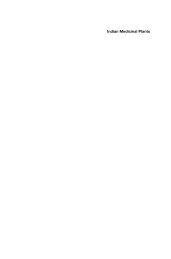a-collection-of-research-articles-on-the-medical-potential-of-cow-urine
a-collection-of-research-articles-on-the-medical-potential-of-cow-urine
a-collection-of-research-articles-on-the-medical-potential-of-cow-urine
You also want an ePaper? Increase the reach of your titles
YUMPU automatically turns print PDFs into web optimized ePapers that Google loves.
Lipid-lowering activity <str<strong>on</strong>g>of</str<strong>on</strong>g> Cow <strong>urine</strong> ark <br />
(Freedman, 2003; Badim<strong>on</strong> et al., 2010).<br />
Reactive oxygen species induce <strong>the</strong><br />
oxidative stress, which play significant<br />
role in <strong>the</strong> development <str<strong>on</strong>g>of</str<strong>on</strong>g> CVD and<br />
a<strong>the</strong>rosclerosis. Liver, kidney and heart are<br />
also under oxidative stress due to<br />
hyperlipidemia in CVD (Kwiterovich,<br />
1997; Vijayakumar et al., 2004). O<strong>the</strong>r<br />
crucial factors regarding CVD, associated<br />
morbidity and mortality, are <strong>the</strong> insulin<br />
resistance, diabetes, elevated blood<br />
pressure, obesity and dyslipidaemia that<br />
are included in metabolic syndrome (Li et<br />
al., 2013). Modern life style like smoking,<br />
alcohol c<strong>on</strong>sumpti<strong>on</strong> and junk food diet<br />
are major obstacles in <strong>the</strong> management <str<strong>on</strong>g>of</str<strong>on</strong>g><br />
dyslipidaemia. Elevated liver enzymes are<br />
<strong>the</strong> major risk factors associated with <strong>the</strong><br />
current allopathic treatment for<br />
dyslipidaemia and thus, <strong>the</strong> alternative<br />
medicines from Ayurveda, have been<br />
getting attenti<strong>on</strong> in <strong>the</strong> management <str<strong>on</strong>g>of</str<strong>on</strong>g><br />
dyslipidaemia (Suanarunsawat et al.,<br />
2011). <br />
Cow <strong>urine</strong>, knownas“Amrita”orwater<br />
<str<strong>on</strong>g>of</str<strong>on</strong>g> life as menti<strong>on</strong>ed in Ayurveda (Dhama<br />
et al., 2005), is <strong>on</strong>e <str<strong>on</strong>g>of</str<strong>on</strong>g> <strong>the</strong> ingredients <str<strong>on</strong>g>of</str<strong>on</strong>g><br />
Panchagavya Ghrita. Panchagavyapathy<br />
was proved to be effective in life<br />
threatening diseases such as diabetes,<br />
cancer and AIDS (Dhama et al., 2005;<br />
Achliya et al., 2003; Jarald et al., 2008).<br />
Cow <strong>urine</strong> has medicinal properties like<br />
antimicrobial, antifungal and anticancer<br />
which granted US Patents (No. 6,896,907<br />
and 6,410,059) (Randhawa, 2010). Several<br />
studies revealed that <strong>cow</strong> <strong>urine</strong> has<br />
antidiabetic and antioxidant activity<br />
(Sachdev et al., 2012; Krishnamurthi et al.,<br />
2004). Therefore, <strong>the</strong> present study was<br />
planned to evaluate <strong>the</strong> lipid lowering<br />
effect <str<strong>on</strong>g>of</str<strong>on</strong>g> Cow <strong>urine</strong> ark (CUA) and also to<br />
know its possible implicati<strong>on</strong> in metabolic<br />
syndrome.<br />
Materials and Methods<br />
Drugs and Chemicals<br />
Cholesterol powder (analytical grade): was<br />
purchased from High Purity Laboratory<br />
Chemicals Pvt. Ltd., Mumbai, India. Cow<br />
<strong>urine</strong> ark (CUA) was obtained from Go<br />
VigyanAnushandhan Kendra, Sevadhanm,<br />
Devalpur, Nagpur, Maharashtra, India and<br />
(US Patent No 6410 059/2002).<br />
Rosuvastatin Calcium powder: (Gift<br />
sample from Torrent Pharmaceuticals Ltd.,<br />
Torrent <str<strong>on</strong>g>research</str<strong>on</strong>g> center, Ahmedabad.<br />
(Batch no: ARD2110109)<br />
Animal preparati<strong>on</strong><br />
Thirty guinea pigs weighing 520 – 860<br />
g <str<strong>on</strong>g>of</str<strong>on</strong>g> ei<strong>the</strong>r sex were procured from <strong>the</strong><br />
Central Animal House <str<strong>on</strong>g>of</str<strong>on</strong>g> Government<br />
Medical College, Bhavnagar, which is<br />
registered in <strong>the</strong> Committee for <strong>the</strong><br />
Purpose <str<strong>on</strong>g>of</str<strong>on</strong>g> C<strong>on</strong>trol and Supervisi<strong>on</strong> <str<strong>on</strong>g>of</str<strong>on</strong>g> <strong>the</strong><br />
Experiments <strong>on</strong> Animals (CPCSEA), New<br />
Delhi, India. CPCSEA guidelines were<br />
followed during animal experiments <str<strong>on</strong>g>of</str<strong>on</strong>g> our<br />
study. The guinea pigs were housed in<br />
stainless steel cages under 12 hour lightdark<br />
cycle room with c<strong>on</strong>trolled<br />
temperature at 23±2°C, being fed with<br />
standard laboratory food and water ad<br />
libitum. After <strong>the</strong> proper acclimatizati<strong>on</strong><br />
for 15 days, <strong>the</strong>y were divided into five<br />
groups <str<strong>on</strong>g>of</str<strong>on</strong>g> six guinea pigs.<br />
Group I: Normal diet plus distilled<br />
water (Vehicle c<strong>on</strong>trol); Group II: High fat<br />
diet plus distilled water (Sham c<strong>on</strong>trol);<br />
Group III: High fat diet plus a lower dose<br />
<str<strong>on</strong>g>of</str<strong>on</strong>g> CUA (0.8 ml/kg); Group IV: High fat<br />
diet plus a higher dose <str<strong>on</strong>g>of</str<strong>on</strong>g> CUA (1.6<br />
ml/kg); Group V: High fat diet plus<br />
rosuvastatin (1.5 mg/kg)<br />
Diet compositi<strong>on</strong> <br />
Normal diet: in <strong>the</strong> morning, mixtures<br />
<str<strong>on</strong>g>of</str<strong>on</strong>g> cereals and pulses (60% wheat plus<br />
35% Bengal gram plus 15% peanuts), total<br />
50 g/animal. In <strong>the</strong> evening: green leafy<br />
vegetables, 30 g/ animal. High fat diet: in<br />
<strong>the</strong> morning, cholesterol powder (500<br />
mg/kg) mixed with 10 g <str<strong>on</strong>g>of</str<strong>on</strong>g> wheat and<br />
Bengal gram flour, followed by 40 g <str<strong>on</strong>g>of</str<strong>on</strong>g> <strong>the</strong><br />
mixtures menti<strong>on</strong>ed above, in <strong>the</strong> normal<br />
diet/animal. In <strong>the</strong> evening: green leafy<br />
vegetables, 30 g/animal.<br />
AJP, Vol. 4, No. 5, Sep-Oct 2014 355









